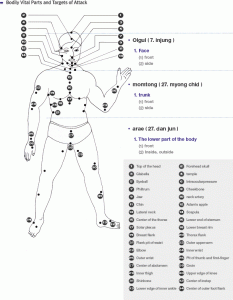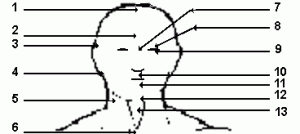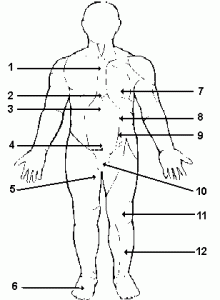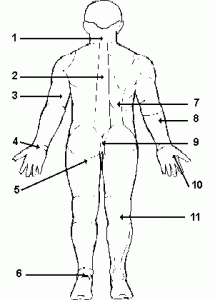“Taekwondo is a martial art for self cultivation, which enables an individual to exert techniques in the air, using bare hands and unmeasured speed and power, and to embody the spiritual integration by means of cultivating spirit and energy to concentrate it on one thing. One can also bring about the physical development through physical motions during the practice of techniques, strengthen the spiritual power to control the body with a strong will and perseverance, and enhance the sense of justice to become a righteous man as a result of repeated self restraints following his or her own judgment of situations and self determination”.
Kukkiwon Website
What are Taekwondo Basics?
Basics by definition, are the fundamental steps, principles, knowledge or ingredients necessary for something to exist. Applying this to Taekwondo, the basics are the building blocks of the art, and they include a series of stances, strikes, blocks, punches, prearranged motions, body targets and state of mind, among other things. In order to be a successful martial artist, you have to learn the basics of your art, by doing so, you will be able to apply techniques in and efficient, effective and safe manner.
In our Dojang, we practice the basics in every class we take. By doing this, we are building mental and muscle memory. Horse ridding stance, single punch, double punch, front kick, half moon kick, etc., might seem tedious and somehow boring, but by repeating the basics, we will be able to react to a situation with the right technique, like is was second nature, without thinking, and who knows, basics might one day save your life!
As an important part of Taekwondo basics, it is necessary to establish a long range goal. Anything that has no end is meaningless. Establishing a goal, is just one of the first things you need to do. In order to reach your goal, whichever it may be, it is necessary to learn and practice the basics.
Here we will talk about some of the basic steps, stances, strikes, blocks, body targets and other basic techniques.
Immediate Targets
Immediate targets are the vital parts of the body, which sense pains at a very slight impact, because of the exposure of nerves under the skin around them. The vital parts on the body as possible target of attack, count approximately 280. However, in this website, we will illustrate 34 of them, dividing the human body into 3 greater parts, i.e., head, trunk and lower part. The most important vital parts of all are the philtrum in the head, the solar plexus in the trunk and the center of abdomen in the lower part.
In training Taekwondo techniques, one must have before him an imaginary opponent of about the same stature with him or her to practice delivering attacks against those three most important vital parts, and defending similar attacks from the imaginary opponent.
- The front of the head
- The front of the body
- The back of the body
The vital points of the body are listed below. A vital point is a part of the body that, when attacked in the right way (force, angle, accuracy), can cause paralysis, unconsciousness or even death. Attacks to nerves can lead to nausea, headaches or worse.
This information should only be used to increase your knowledge of the body and of Taekwondo, it is not meant to be used without the supervision of a qualified instructor.
The impact on vital points is indicated by numbers as followed:
- Moderate pain
- Sharp pain
- Severe pain
- Unconsciousness or temporary paralysis
- Fatal
Remember that the body has about 280 vital points so this list is far from complete.
The front of the head:
| Number | Description | Result of light impact | Result of full-power attack |
| 1 | Top of head | 2 | 4 |
| 2 | Forehead | 2 | 4 |
| 3 | Temple | 3 | 5 |
| 4 | Cheekbone | 2 | 4 |
| 5 | Neck artery | 3 | 5 |
| 6 | Cervical trachea | 3 | 5 |
| 7 | Glabella | 2 | 4 |
| 8 | Intraocular pressure | 2 | 4 |
| 9 | Eyeball | 2/3 | 4/5 |
| 10 | Philtrum | 1/2 | 3/4 |
| 11 | Jaw | 2 | 4 |
| 12 | Chin | 2 | 4 |
| 13 | Adam’s apple | 3 | 5 |
The front of the body:
| Number | Description | Result of light impact | Result of full-power attack |
| 1 | Center of thorax | 2 | 4 |
| 2 | Lower end of sternum | 3 | 5 |
| 3 | Solar plexus | 3 | 5 |
| 4 | Center of abdomen | 2 | 4 |
| 5 | Inner thigh | 2 | 4 |
| 6 | Center of instep | 2 | 4 |
| 7 | Brest | 1 | 3 |
| 8 | Thorax flank | 2 | 4 |
| 9 | Flank pit of waist | 2 | 4 |
| 10 | Groin | 3 | 5 |
| 11 | Upper knee-edge | 2 | 4 |
| 12 | Shin | 1 | 3 |
The back of the body:
| Number | Description | Result of light impact | Result of full-power attack |
| 1 | Back of the neck | 3 | 5 |
| 2 | (several parts of) backbone | 3 | 5 |
| 3 | Outside of upper arm | 1 | 4 |
| 4 | Outer-wrist | 1 | 3 |
| 5 | Hip nerve | 2 | 4 |
| 6 | Achilles heel | 2 | 4 |
| 7 | Kidneys | 2 | 4 |
| 8 | Elbow (just below) | 1 | 3 |
| 9 | Coccyx | 2 | 4/5 |
| 10 | Pit of thumb and first-finger | 2 | 4 |
| 11 | Knee pit | 1 | 3 |





